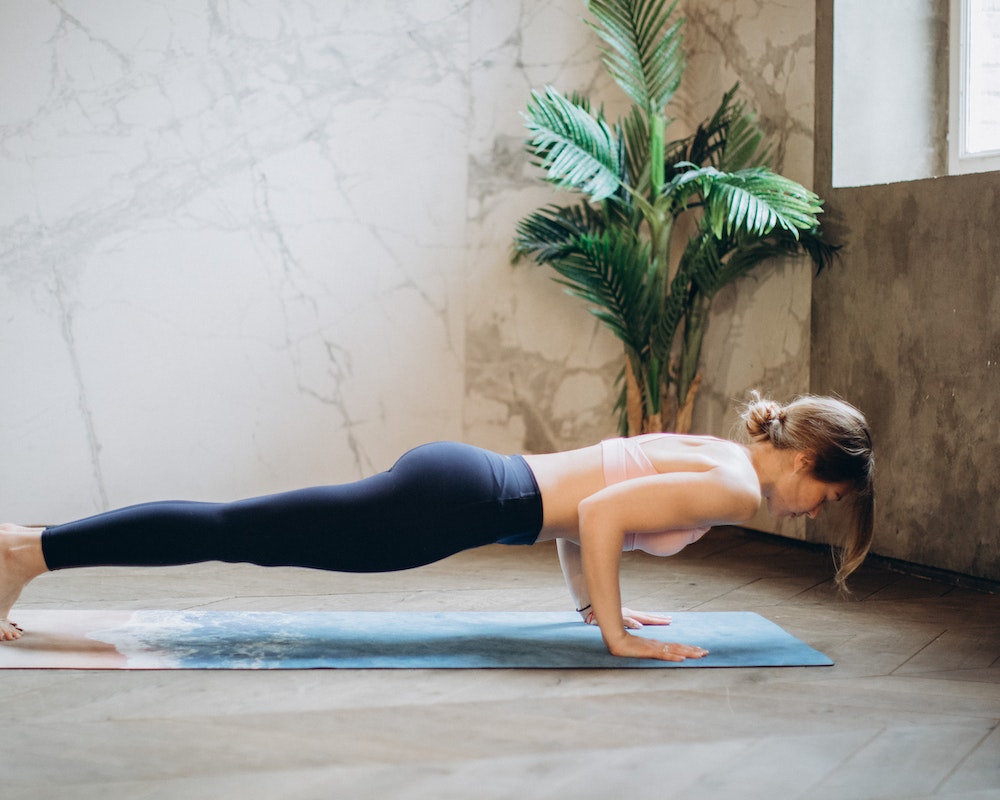Regular exercise helps improve brain health and manage weight. It also strengthens bones and reduces health risks. But what’s the best way to get started?
Isometric exercises are popular for people who want to ease into a workout routine. Also known as static strength training, there are many benefits to isometric training. They’re great for beginners because they’re low impact and don’t require a lot of coordination. They’re also safe if you have certain health conditions, such as arthritis.
These exercises don’t require equipment and can be done anywhere. As a result, this type of exercise falls under “fitness trends you can do at home.”
What is an Isometric Exercise?
Isometric exercises involve contracting your muscles without moving any joints. In other words, you’re statically holding a position for an extended period. The constant muscle tension supports dynamic exercises and improves muscle endurance.
Many muscle strengthening exercises require joint movement and using the muscles to pull or push against resistance. However, a typical isometric exercise routine puts tension on the muscles without moving the joints. Isometric exercises improve posture and physical endurance by stabilizing and strengthening the muscles.
Should you Perform Isometric Exercises?
If you’re starting a new exercise routine, isometric exercises might be your first pick. But is it the right routine for you? The answer depends on your fitness goals and what you hope to achieve from working out.
Muscle Endurance
If your goal is to improve muscle endurance, then starting with isometric exercises can be beneficial. Holding the contraction for a long time puts your muscles through an endurance test. Over time, your muscles will become stronger and can easily handle extended periods of tension.
Muscle Strength
If you’re looking to improve your strength, however, you might want to start with traditional exercises that involve moving your joints. These exercises allow you to work against resistance, which can help build muscle strength.
No matter what your fitness goals are, performing isometric exercises can be a helpful addition to your workout routine. It helps you gradually increase the intensity and duration of your workouts. This will help you build muscle endurance and strength, which are essential for overall fitness.
Benefits of Isometric Training

Isometric training offers numerous benefits, even compared to other exercises. These benefits include:
Isometric Exercises Are Perfect for All Levels of Fitness
Adapt an isometric exercise routine to your fitness level as a beginner or a seasoned athlete. All you need to do is adjust the amount of resistance used. So, consider incorporating isometric exercises into your workout regimen.
Isometric Exercises Facilitate Muscle Growth
They are also helpful in activating muscle fibers simultaneously. Muscle activation can lead to an increase in muscle size, a process known as muscle hypertrophy. The process of growing muscles happens when muscle fibers sustain damage. Muscle mass and size increase as the body repairs the damage.
Isometric Training Don’t Require Much Time or Equipment
Isometric exercises can be done anywhere and at any time. All you need is your body weight for resistance. This makes the routine ideal for busy people who don’t have much time for workouts. It also means that isometric training is one of the best ways to sneak in workouts without feeling like exercising.
Isometric Exercises Are Safe and Effective
Isometric exercises are a safe and effective way to build strength. They’re also suitable for people with a medical condition or injury. A physical therapist or healthcare provider may recommend these exercises to people with an injured rotator cuff. The exercises help maintain shoulder strength while the person is recovering.
Isometric Training Can Help Lower Blood Pressure
Studies indicate that isometric exercise training can lower blood pressure. This is likely because isometric exercises improve blood vessel function. Dynamic resistance training and physical activity can also reduce blood pressure. But always adjust your exercise intensity if you are experiencing high blood pressure since an intense workout can cause your blood pressure to rise.
Isometric Exercises Can Enhance Muscle Stability
While resistance training does not increase athletic performance or speed, it can enhance muscle stability. Isometric exercises may also improve your ability to hold your weight over a long period. These exercises are for you if you want to enhance stabilization and you have tight muscles.
Always start with a lower weight and increase the amount of resistance gradually to get the most out of isometric training.
Isometric Strength Training Exercises
There are many isometric exercises that you can do to improve your muscle strength. When going through isometric training, you should remember that you should always start with your weaker side first. So, if you have difficulty lifting your left leg, start doing isometric exercises for your left leg before progressing to your right leg.
Basics of Isometric Training Exercises
An isometric exercise involves muscle contraction to provide tension without moving the joints. Muscle contraction occurs without changing the length of the muscle. It has three types:
- Concentric Contraction: The contraction where the muscle tension overcomes the resistance to shorten the muscle. For example, when you curl a dumbbell, your biceps contract concentrically to lift the weight.
- Eccentric Contraction: The contraction where the muscle lengthens under load. For example, when you lower the dumbbell back down from the curl, your biceps eccentrically contract to control the weight.
- Isometric Contraction: The contraction where the muscle tension develops but the muscle length does not change. For example, when you hold a weight in the curl position, your biceps isometrically contract to maintain that position.
Examples of Isometric Training Exercises
Some examples of isometric training exercises that you can do to improve your muscle strength include:
- Plank. The plank is a popular isometric exercise. It involves isometric contractions of the core muscles responsible for stabilizing your spine and pelvis. To perform a plank, position yourself as if you were going to perform a push-up and fully extend your harms with your hands placed directly beneath the shoulders. Proper form is essential when performing a plank. While the plank is a great exercise, it’s not the only isometric exercise out there. You can perform different isometric exercises to target different muscle groups.
- Squat Hold. Another popular type of isometric exercise is the squat hold. The exercise develops postural stability of the lower limbs, which can be helpful for people who want to improve their squat form. The squat hold can be performed with resistance bands, free weights, or your body weight, depending on your current ability and preference. If you’re new to isometric exercises, starting with a simple exercise like the squat hold is best. Once you’re comfortable with the exercise, gradually increase the intensity by adding more resistance. Isometric exercises are a great way to build strength and improve overall fitness.
- Glute Bridge. This exercise focuses on the gluteal muscles. You should lie on your back and thrust your hips upward to perform the exercise. The isometric hold at the top of the bridge will increase muscular endurance and improve lower back health. If you are new to working out or have not exercised in a while, it is essential to start slowly and gradually increasing the intensity of your workouts. You can incorporate isometric exercises into your workout regimen to ease into a more strenuous routine.
- Wall Sit. Another simple isometric exercise is wall sitting. This one is great for improving thigh muscle endurance without straining the lower back muscles. To do a wall sit, stand with your feet shoulder-width apart and your back pressed against a wall. Lower yourself until your knees and hips are at right angles, and your thighs are parallel to the floor.
- Dead Hang. The dead hang is an isometric exercise that helps improve grip strength. It also works the muscles in your back, shoulders, and arms. If you’re new to isometric exercises, start with a dead hang. To do a dead hang, find a bar at about shoulder height that you can grip securely with both hands. Hang from the bar with your feet off the ground and your arms fully extended. You should ensure your body is in a straight line. Hold this position for as long as you can without moving. As you get stronger, try holding the dead hang for long periods.
Tips for Performing Isometric Exercises
Isometric exercise training offers several benefits if you perform them correctly. Here are some tips to help you attain your fitness goals.
Breathe Correctly
Performing different isometric exercise types requires you to master proper breathing. The most common mistake is holding your breath while performing the exercise. When you do this, you aren’t getting the full benefit of the training because you’re not receiving enough oxygen. You also put unnecessary strain on your heart and other muscles.
Practicing deep breathing from your diaphragm while performing isometric exercises helps you do better.
Remember to Squeeze
These exercises do not rely on movement for muscle activation. So, you have to squeeze your muscles instead. Squeezing the muscles is also known as maximal voluntary contraction, where you exert effort to tighten your muscles.
Maintain Proper Form
Proper form is essential for injury prevention. Maintaining proper form is crucial for isometric exercises even if you do not have a lot of weight against you. You can also test different angles to increase muscle strength. Exercising in different forms targets different muscle groups.
Overall, Isometric exercises are a great way to start exercising. They help prevent injuries and increase muscle strength. With this routine, make sure to focus on proper form and different angles. This will help create a strong foundation for other exercises down the road.



